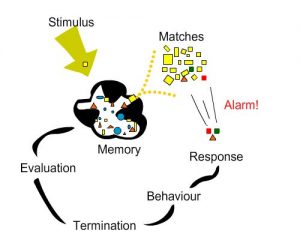Behavior Cycle Hypnotherapy
Automatic Behavior Trigger Button Inappropriate Response
The Behavior Cycle: Situation Specific Behavior
A great many of the problems presented to hypnotherapists are about specific situations where the person has to deal with some sort of trigger event. The client gets forced into a behavior that they do not want, do not understand, and have no control over. This is called the behavior cycle.
A great deal of our behavior is automatic and unconscious. When you find yourself in any situation that has some emotional outcome you create a behavior cycle. Your mind records the defining elements of the situation, what happened, how you responded to it, and what the outcome was.
The next time you meet a new situation your mind goes searching for previous situations that have similar elements. Your mind then makes the best match it can between your previously recorded situations and the current one. Your response to the current situation will be based on what worked in the most closely matching previous situation.
The advantage of this matching process is that you do not have to think about what to do the next time you encounter a chair, or a sunset, or a car coming towards you. You just react the way you did before. However, this can lead to inappropriate behavior.
THE BEHAVIOR CYCLE
| Situation | Where does it happen? |
| Stimulus | What sets it off? |
| Memory | What does it remind you of? |
| Reaction | How do you react to it? |
| Termination | How does your behavior end? |
| Evaluation | Does the behavior deal with the situation? |
| Learning | What lessons do you take from the incident? |
The Cycle of Behavior
THE CASE OF MRS SQUEAK
Suppose you have someone who is terrified of mice. They don't know why they are scared of mice but they always have been. Even the thought of the nasty squeaky sneaky crawly little vermin anywhere near them sends them into a panic and they run screaming out of the room. The reaction is way out of proportion to the threat.
What is happening is that they have become trapped in a cycle of stimulus, reaction and evaluation. The diagram below shows the stages of the cycle.

Stimulus
The stimulus can be anything in the environment, where the environment includes your own imaginings. Typically, our mouse avoider would be sitting doing nothing much when she becomes aware of a tiny noise. That is the stimulus. The problem arises because every stimulus sets off a process that results in retrieving a flood of associated memories. Some are good, some bad, the vast majority are neutral and each is associated with other memories in a giant continuous cascade that never stops.
This is why an unexpected image or taste can transport you back in time. Suppose you taste a flavour of ice cream. Just that taste can recreate a holiday you had years ago, and the memory floods your mind complete with sounds and colors and feelings. The feelings can be good or bad. If you had a wonderful time that's OK. If you were hurt by somebody you will probably associate feeling bad with the ice cream and therefore will tell your self you don't like that flavour. In fact it has nothing to do with the ice cream, it has everything to do with wanting to avoid being reminded of past hurts. Our minds make associations like that constantly, automatically and very easily.
Retrieval
The human mind is outstandingly good at finding similarities between different situations. This is both a strength and a weakness. Mrs Squeak's mind registers the stimulus subconsciously and goes into her memory to find matching situations. Her subconscious has been doing this constantly all the time. Her subconscious has been monitoring her heartbeat, hunger level, temperature, the pressure of her legs on the seat and thousands of other stimuli simultaneously, and doing this automatically and effortlessly. It has also been paying attention to every sight, sound and smell that has come along. Mrs Squeak is unaware that she has heard the sound of a car door slam and ignored it, and heard a dog bark and ignored it. In each case her subconscious went into her memory and examined a torrent of information about each. One stimulus such as the dog bark causes her mind to examine every memory associated with dogs barking. Her mind will instantly flash over thousands of related and associated memories to do with friends who are dog owners, stories about dogs, times when she couldn't sleep because a dog was barking. Each of these fragments of memory is found, scanned and discarded in a fraction of second. Thousands and thousands of images, smells, tastes, touches making up memories associated with barking are blasted through almost instantaneously. Mrs Squeak doesn't have any particularly powerful memories associated with car doors or dogs barking or she would have reacted in some way.
Reaction
But Mrs Squeak does have thing about mice. When her subconscious registers the tiny sound it dives into her memories and begins ripping through thousands of instances of sounds and suddenly finds one or two associations between tiny sounds and tiny creatures. Mrs Squeak's mind learned once that there is danger associated with tiny creatures. The sound implies that there could be danger right now so her mind diverts instantly to her survival routine.
Actions
Without even being aware of what she is doing Mrs Squeak is on her feet and heading out of the door. She has no idea why she is suddenly running out of the door and this causes her even more alarm and makes her run even faster. She is now running, panicking, out of control, acting purely on instinct to preserve her safety. The entire reaction is causing panic, embarrassment and distress.
Termination
At some point something registers in her attention and she becomes aware of what she it doing. She realizes there is no danger, and her normal reactions set in. She looks around perhaps, inspects the room, realizes the sound was the curtain moving, that there is nothing to fear.
Evaluation
But she is left with the palpitations, her heart is pounding, her adrenalin has shot up, she is shaky and maybe she is embarrassed if there are other people there. She then remembers other times when she behaved like a fool and ran around screaming and that makes her feel even worse.
Reinforcement
The cycle then completes when her subconscious applies its learning process to the situation. The subconscious logic is impeccable. There was an indication of a mouse, Mrs Squeak ended up frightened and feeling bad - the sound caused it. To avoid feeling bad she was rushed out the room and then started to feel better. Therefore getting her out of the room resulted in her feeling better. Therefore the next time she hears a tiny sound her subconscious guardian will snap into action and catapult her out of the room again. The reaction is filed away in memory as the absolutely correct way to behave. Mrs Squeak's subconscious is doing what it is supposed to do, to keep her safe. Unfortunately the learning process has now learned the wrong association. The mouse is now irrelevant, she is reacting to her own reaction.
Breaking the behavior cycle
A chain is only as strong as its weakest link. If any one link is broken then the cycle is broken. It does not matter how long the chain is, or how long it has been there, or where it came from: breaking it at any point destroys it for ever. A cycle that reinforces itself only has to be broken once. That is what your hypnotherapy aims to do.
Modeling the cycle
The first step in the therapy is for the hypnotherapist to understand exactly how the cycle works. Each person experiences their particular trigger situation differently, so a solution needs to be created to exactly match each stage.
The therapist will spend time getting the client to explain how the cycle operates for them. The aim is to get the client to teach you to do what he does and how he does it. You need to know exactly what sets it off, what makes it stop, what he does when he reacts.
Then you design an interupt for each stage of the cycle. Many client cycles are quite complicated. If you can interrupt any one of the stages then the cycle is broken, so the more stages the better, and the more you understand how the client experiences each stage the more easily you can disrupt the process.
Planning to break the cycle
The intervention starts with the stimulus. Most stimulus are not simple and instantaneous so the client can be taught to reframe the situation. There is usually a build up towards the trigger, so that is good target. For example public speaking usually requires some sort of preparation and journey to the room. All of these offer opportunities to redefine how they can be handled.
It is also usually possible to change the meaning of the stimulus. If you get tongue tied because the boss looks angry, there is usually scope to redefine the angry look as being the result of his home life, or a hurried lunch or whatever. Any alternative will succeed in derailing the automatic process if it can be invoked in time.
Change the memory
Similarly it is possible to examine what it is in memory that is provoking such a reaction. There are various therapy techniques which can find and defuse the memories which are triggering the bad feelings.
Each stage offers its own opportunities for intervention. That behavior stage can be attacked by getting the client to visually rehearse a different behavior that will be triggered by the reaction. Once the new behavior has proven to be better than the automatic behavior, your subconscious will learn to use that instead. A different, more acceptable behavior cycle will be created.
HTUT09









